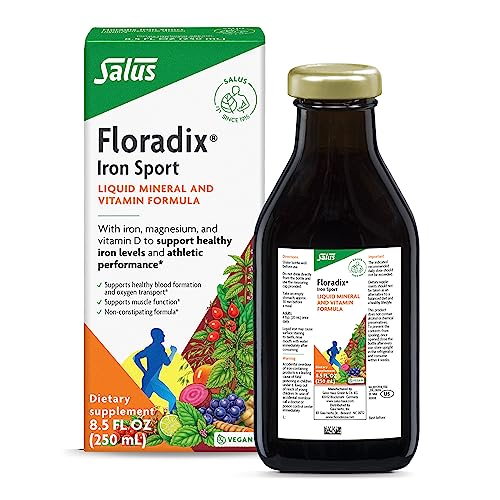
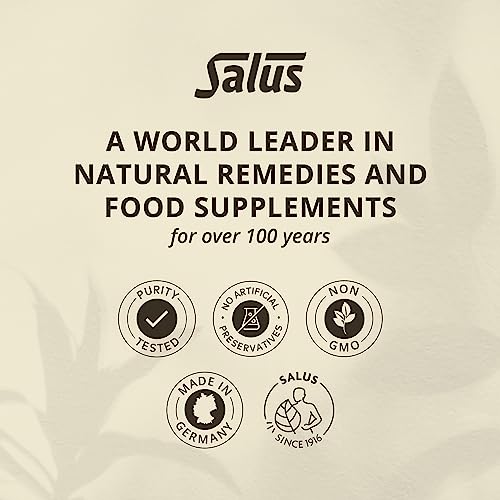
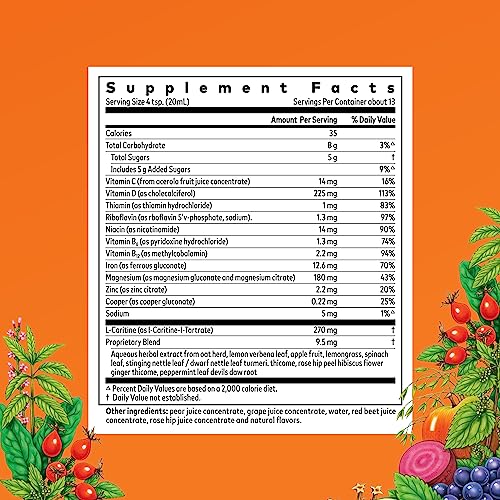
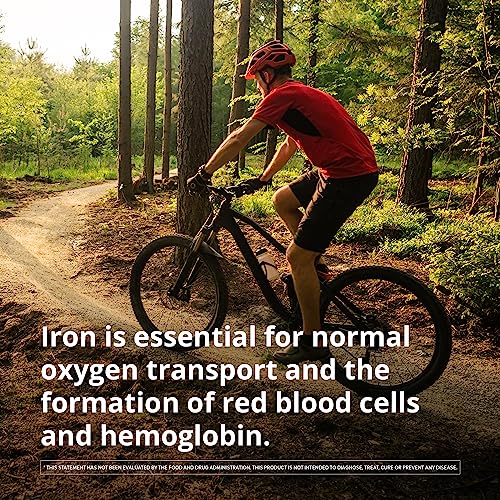
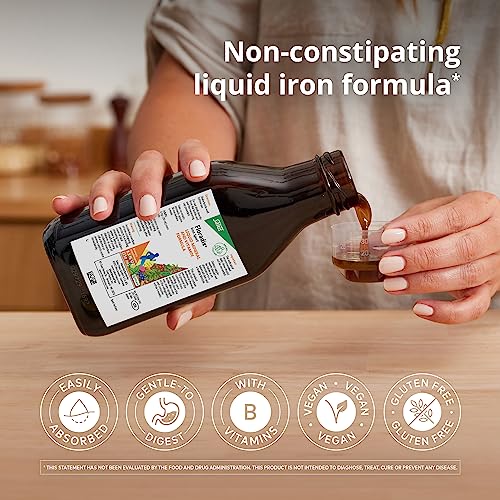

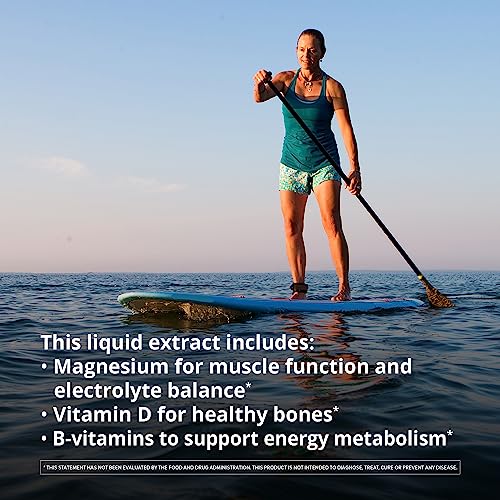
Floradix Iron Sport Multivitamin - Energy & Muscle Support, Vegan, Non-GMO - 8.5 fl oz


Vitamin D3
High RiskVitamin D3, also known as cholecalciferol, is a fat-soluble vitamin important for calcium metabolism and bone health. It is synthesized in the skin upon exposure to sunlight and is also found in some foods and supplements. Its primary function is to promote the absorption of calcium and phosphorus in the body.
Sustai Insights
Vitamin D3 offers functional benefits such as supporting bone health and immune function. However, excessive intake can lead to toxicity, presenting risks like hypercalcemia. Environmental concerns include its potential for bioaccumulation. Regulatory bodies impose usage restrictions due to these risks, resulting in a high overall risk assessment. Safe usage practices should be observed, and alternatives such as vitamin D2 may be considered.
Cymbopogon Schoenanthus (Lemongrass)
High RiskCymbopogon schoenanthus, commonly known as lemongrass, is a tropical plant used primarily for its aromatic properties in culinary and cosmetic applications. It is often included for its potential antimicrobial and antioxidant effects, contributing to product preservation and fragrance.
Sustai Insights
Lemongrass offers functional benefits as a natural preservative and fragrance agent. However, it may pose risks due to its high allergenic potential and enhanced skin absorption, which could lead to irritation in sensitive individuals. Regulatory bodies have noted its restricted use in certain formulations. Overall, its risk level is assessed as high, particularly for those with allergies. Safe usage practices should be followed, and alternatives like citral-free essential oils could be considered.
Mentha Piperita (Peppermint) Leaf
High RiskMentha piperita (peppermint) leaf is derived from the dried leaves of the peppermint plant, commonly used in cosmetic formulations for its aromatic properties and potential soothing effects on the skin. It is often included for its flavoring and fragrance capabilities in various personal care products.
Sustai Insights
Mentha piperita offers functional benefits as a natural fragrance and potential skin soothing agent, contributing to product sensory experiences. However, it carries a high allergenic potential, which may pose risks for sensitive individuals. While generally low in carcinogenicity and reproductive toxicity, regulatory scrutiny exists, emphasizing caution in formulations. Environmental concerns are minimal, but users are advised to monitor for allergic reactions. Overall, the ingredient presents a high risk level due to its allergenic properties, warranting careful usage and consideration of alternatives like less allergenic essential oils.
Zinc
Medium RiskZinc is a trace mineral essential for various biological functions, including immune system support and cellular metabolism. It is commonly used in topical products for its antibacterial properties and is often included in formulations for skin health and wound healing.
Sustai Insights
Zinc offers functional benefits such as promoting skin health and providing antimicrobial effects, and it can be sustainably sourced. However, it poses moderate environmental risks due to potential bioaccumulation. Health risks are generally low, with concerns mainly related to developmental and reproductive toxicity at high exposures. Regulatory bodies have imposed some restrictions on its use, indicating a medium overall risk assessment. Safe usage practices should be followed, and alternatives like magnesium may offer similar benefits with lower risks.
Vitamin B3
Low RiskVitamin B3, also known as niacin or nicotinic acid, is an organic compound that plays a crucial role in various metabolic processes in the body. It is commonly used in cosmetic formulations for its ability to improve skin texture and enhance moisture retention, thereby contributing to overall skin health.
Sustai Insights
Vitamin B3 offers functional benefits such as improving skin hydration, reducing the appearance of fine lines, and enhancing overall skin tone. It is generally recognized as safe, with low associated health risks, including minimal concerns for carcinogenicity, allergies, or reproductive toxicity. Environmentally, it poses low risks and is not classified as a pollutant or bioaccumulative. Regulatory bodies have not placed substantial restrictions on its use, affirming its safety in cosmetic applications. Overall, Vitamin B3 is considered a low-risk ingredient, with no significant adverse effects reported. Safe usage practices include using within recommended concentrations, and alternatives like Vitamin B5 can be considered for similar benefits.
Sodium
Low RiskSodium is a chemical element commonly used in various products, primarily as a preservative and stabilizing agent. It is involved in numerous reactions, contributing to the overall functionality and safety of formulations.
Sustai Insights
Sodium serves as an effective preservative, helping to extend product shelf life. It is generally recognized as safe with low concerns for carcinogenicity, allergies, and reproductive toxicity. However, excessive exposure may lead to health issues like hypertension. Environmentally, sodium is considered low risk regarding pollution and bioaccumulation. Regulatory bodies have not imposed significant restrictions on its use. Overall, the risk associated with sodium is low, making it a suitable ingredient with no major health or environmental concerns.
Pyrus Malus (Apple) Fruit
Low RiskPyrus malus (apple) fruit is the fruit of the apple tree, commonly used in cosmetic formulations. It serves various functions, including acting as a moisturizer and providing antioxidant properties due to its natural compounds.
Sustai Insights
Pyrus malus (apple) fruit offers functional benefits such as moisturizing and antioxidant effects, contributing to skin health. It is sustainably sourced and poses low health risks, with minimal concerns regarding carcinogenicity, allergenic potential, or developmental toxicity. Environmental impacts are also low. Regulatory bodies do not impose significant restrictions on its use, classifying it as low risk overall. Safe usage practices include adhering to recommended concentrations in product formulations. Alternatives like other fruit extracts may provide similar benefits with comparable safety profiles.
Carnitine
Low RiskCarnitine is a naturally occurring compound involved in the metabolism of fatty acids, primarily functioning as a transporter of fatty acids into the mitochondria for energy production. It is commonly used in dietary supplements and cosmetic formulations for its potential energy-boosting and fat-burning properties.
Sustai Insights
Carnitine offers functional benefits in enhancing fat metabolism and energy production, which may support weight management and athletic performance. It is generally considered low risk regarding health impacts, with minimal concerns for carcinogenicity, allergies, or developmental toxicity. Environmental risks are also low, as carnitine is not a significant pollutant or bioaccumulative. Regulatory bodies have not imposed major restrictions, although verified products should adhere to guidelines. Safe usage practices include adherence to recommended dosages, and while alternatives exist, such as other fatty acid transporters, carnitine remains a viable option in formulations. Overall, the ingredient's risk level is assessed as low.
Thiamin
Low RiskThiamin, also known as vitamin B1, is a water-soluble vitamin essential for carbohydrate metabolism and nerve function. It serves as a coenzyme in the conversion of food into energy and is important for maintaining healthy nerve cells and muscle function.
Sustai Insights
Thiamin plays a crucial role in energy metabolism and supports nerve health, with minimal associated health risks such as low carcinogenicity and low allergenic potential. It is not currently subject to restrictions by regulatory bodies. While thiamin is not known to pose significant environmental risks, its production should be monitored for sustainability. Safe usage practices include ensuring adequate dietary intake, particularly in vulnerable populations. Given the overall low risk associated with thiamin, it is considered a safe ingredient in product formulations.
Magnesium
Low RiskMagnesium is a mineral commonly found in various products, serving primarily as a nutrient that supports multiple biological functions, including muscle and nerve function, and energy production. It is often included in dietary supplements and fortified foods to address magnesium deficiency.
Sustai Insights
Magnesium offers functional benefits such as aiding in muscle relaxation and energy production, making it an important nutrient. It is sustainably sourced and generally considered low risk, with minimal health concerns related to cancer, allergies, or reproductive toxicity. Environmental risks are also low, as it does not contribute significantly to pollution or bioaccumulation. Regulatory status is favorable, with no current restrictions. Safe usage practices involve adhering to recommended dietary allowances. Overall, magnesium is a low-risk ingredient with no significant adverse effects, making it a suitable choice in various applications.
Zingiber Officinale (Ginger) Root Extract
Low RiskZingiber officinale (ginger) root extract is derived from the ginger plant, widely recognized for its use in culinary applications and traditional medicine. It serves various functions in products, including flavor enhancement and potential therapeutic benefits due to its bioactive compounds.
Sustai Insights
Ginger root extract offers functional benefits such as flavoring and possible anti-inflammatory properties. It is sustainably sourced and biodegradable. Health risks are low, with minimal concerns regarding carcinogenicity, allergies, or reproductive toxicity. Environmental risks appear low, with no significant pollutants. Regulatory status is favorable, with no major warnings. Overall, the risk level associated with ginger root extract is low, making it a suitable ingredient in various applications.
Riboflavin
Low RiskRiboflavin, also known as Vitamin B2, is a water-soluble vitamin essential for energy production and cellular function. It plays a critical role in the metabolism of fats, carbohydrates, and proteins, and is commonly used as a dietary supplement and food additive for its color and nutritional benefits.
Sustai Insights
Riboflavin offers functional benefits, including its role in energy metabolism and as a food colorant. It is generally recognized as safe with low risk for allergies, carcinogenicity, and reproductive toxicity. However, excessive intake can lead to minor side effects such as yellow urine. Environmentally, riboflavin poses low pollutant potential and is not bioaccumulative. Regulatory bodies like the FDA have approved its use, establishing a low risk profile overall. Recommended usage levels are safe, and alternatives include other B vitamins, ensuring a balanced intake.
Hibiscus Sabdariffa Leaf
Low RiskHibiscus sabdariffa leaf is a dried, crushed leaf derived from the hibiscus plant, commonly used for its flavor and potential health benefits in various products. It is often included in herbal teas and dietary supplements due to its rich antioxidant content.
Sustai Insights
Hibiscus sabdariffa leaf offers functional benefits, including antioxidant properties and potential support for cardiovascular health. It is sustainably sourced and generally recognized as safe, with low concerns regarding carcinogenicity, allergies, or reproductive toxicity. Environmental risks are minimal, as it does not significantly contribute to pollution or bioaccumulation. Regulatory bodies do not impose restrictions on its use. However, users should be mindful of individual sensitivities. Overall, the ingredient is assessed as low risk, with no notable health or environmental concerns.
Ascorbic Acid (Vitamin C)
Low RiskAscorbic acid (Vitamin C) is a naturally occurring antioxidant essential for various biological functions, including collagen synthesis and immune response. It is commonly used in cosmetic and food products for its preservative properties and ability to enhance skin brightness.
Sustai Insights
Ascorbic acid provides functional benefits as an effective antioxidant and preservative, contributing to skin health and product stability. It is generally recognized as safe with low health risks, including minimal concerns for carcinogenicity and allergies. Environmentally, it poses low risks, as it is biodegradable and does not bioaccumulate. Regulatory bodies like the FDA have not imposed significant restrictions on its use. Overall, the ingredient presents a low risk, with safe usage practices ensuring consumer safety, and alternatives such as natural extracts exist for those seeking different formulations.
Iron
Low RiskIron is a mineral that plays a vital role in various biological processes, primarily as a component of hemoglobin in red blood cells, facilitating oxygen transport. It is commonly used in dietary supplements and food fortification to address iron deficiency and support overall health.
Sustai Insights
Iron offers essential functional benefits, such as improving oxygen circulation and supporting metabolic processes. It is generally considered safe with low risks for carcinogenicity, allergenic potential, and reproductive toxicity. Regulatory bodies like the FDA do not impose significant restrictions on its use. However, excessive iron intake can lead to health risks, including toxicity. Environmentally, iron is not known to be a pollutant or bioaccumulative. Overall, iron is assessed as low risk, with safe usage practices advised, including monitoring intake levels. Alternatives for supplementation include dietary sources like spinach and legumes.
Cyanocobalamin (Vitamin B12)
Low RiskCyanocobalamin, commonly known as vitamin B12, is a water-soluble vitamin essential for red blood cell formation, neurological function, and DNA synthesis. It is utilized in dietary supplements and fortified foods to prevent or treat B12 deficiency, particularly in individuals with limited dietary intake or absorption issues.
Sustai Insights
Cyanocobalamin serves critical physiological functions including energy metabolism and red blood cell production. It is deemed safe with low health risk concerns across various categories such as cancer, allergies, and reproductive toxicity. Environmental impact is minimal, lacking bioaccumulation or significant pollutants. Regulatory bodies, including the FDA, recognize its safety, affirming low risk overall. Recommended usage involves adherence to established dietary allowances, with few noted alternatives. Therefore, the overall assessment indicates low risk.
Pyridoxine
Low RiskPyridoxine is a substituted aromatic compound, primarily known as vitamin B6. It plays a crucial role in various metabolic processes, including amino acid metabolism, neurotransmitter synthesis, and the production of hemoglobin.
Sustai Insights
Pyridoxine serves essential functions in metabolic processes and is vital for overall health. It poses low health risks, with minimal concerns related to carcinogenicity, allergies, or reproductive toxicity. Environmentally, it is not considered a pollutant or bioaccumulative. Regulatory bodies have not imposed significant restrictions, indicating a low risk overall. Safe usage practices are encouraged, and alternatives like other B vitamins can be considered.
Vitamin B3
Low RiskVitamin B3, also known as niacin or nicotinic acid, is an organic compound that plays a crucial role in various metabolic processes in the body. It is commonly used in cosmetic formulations for its ability to improve skin texture and enhance moisture retention, thereby contributing to overall skin health.
Sustai Insights
Vitamin B3 offers functional benefits such as improving skin hydration, reducing the appearance of fine lines, and enhancing overall skin tone. It is generally recognized as safe, with low associated health risks, including minimal concerns for carcinogenicity, allergies, or reproductive toxicity. Environmentally, it poses low risks and is not classified as a pollutant or bioaccumulative. Regulatory bodies have not placed substantial restrictions on its use, affirming its safety in cosmetic applications. Overall, Vitamin B3 is considered a low-risk ingredient, with no significant adverse effects reported. Safe usage practices include using within recommended concentrations, and alternatives like Vitamin B5 can be considered for similar benefits.
Sodium
Low RiskSodium is a chemical element commonly used in various products, primarily as a preservative and stabilizing agent. It is involved in numerous reactions, contributing to the overall functionality and safety of formulations.
Sustai Insights
Sodium serves as an effective preservative, helping to extend product shelf life. It is generally recognized as safe with low concerns for carcinogenicity, allergies, and reproductive toxicity. However, excessive exposure may lead to health issues like hypertension. Environmentally, sodium is considered low risk regarding pollution and bioaccumulation. Regulatory bodies have not imposed significant restrictions on its use. Overall, the risk associated with sodium is low, making it a suitable ingredient with no major health or environmental concerns.
Pyrus Malus (Apple) Fruit
Low RiskPyrus malus (apple) fruit is the fruit of the apple tree, commonly used in cosmetic formulations. It serves various functions, including acting as a moisturizer and providing antioxidant properties due to its natural compounds.
Sustai Insights
Pyrus malus (apple) fruit offers functional benefits such as moisturizing and antioxidant effects, contributing to skin health. It is sustainably sourced and poses low health risks, with minimal concerns regarding carcinogenicity, allergenic potential, or developmental toxicity. Environmental impacts are also low. Regulatory bodies do not impose significant restrictions on its use, classifying it as low risk overall. Safe usage practices include adhering to recommended concentrations in product formulations. Alternatives like other fruit extracts may provide similar benefits with comparable safety profiles.
Carnitine
Low RiskCarnitine is a naturally occurring compound involved in the metabolism of fatty acids, primarily functioning as a transporter of fatty acids into the mitochondria for energy production. It is commonly used in dietary supplements and cosmetic formulations for its potential energy-boosting and fat-burning properties.
Sustai Insights
Carnitine offers functional benefits in enhancing fat metabolism and energy production, which may support weight management and athletic performance. It is generally considered low risk regarding health impacts, with minimal concerns for carcinogenicity, allergies, or developmental toxicity. Environmental risks are also low, as carnitine is not a significant pollutant or bioaccumulative. Regulatory bodies have not imposed major restrictions, although verified products should adhere to guidelines. Safe usage practices include adherence to recommended dosages, and while alternatives exist, such as other fatty acid transporters, carnitine remains a viable option in formulations. Overall, the ingredient's risk level is assessed as low.
Zinc
Medium RiskZinc is a trace mineral essential for various biological functions, including immune system support and cellular metabolism. It is commonly used in topical products for its antibacterial properties and is often included in formulations for skin health and wound healing.
Sustai Insights
Zinc offers functional benefits such as promoting skin health and providing antimicrobial effects, and it can be sustainably sourced. However, it poses moderate environmental risks due to potential bioaccumulation. Health risks are generally low, with concerns mainly related to developmental and reproductive toxicity at high exposures. Regulatory bodies have imposed some restrictions on its use, indicating a medium overall risk assessment. Safe usage practices should be followed, and alternatives like magnesium may offer similar benefits with lower risks.
Thiamin
Low RiskThiamin, also known as vitamin B1, is a water-soluble vitamin essential for carbohydrate metabolism and nerve function. It serves as a coenzyme in the conversion of food into energy and is important for maintaining healthy nerve cells and muscle function.
Sustai Insights
Thiamin plays a crucial role in energy metabolism and supports nerve health, with minimal associated health risks such as low carcinogenicity and low allergenic potential. It is not currently subject to restrictions by regulatory bodies. While thiamin is not known to pose significant environmental risks, its production should be monitored for sustainability. Safe usage practices include ensuring adequate dietary intake, particularly in vulnerable populations. Given the overall low risk associated with thiamin, it is considered a safe ingredient in product formulations.
Vitamin D3
High RiskVitamin D3, also known as cholecalciferol, is a fat-soluble vitamin important for calcium metabolism and bone health. It is synthesized in the skin upon exposure to sunlight and is also found in some foods and supplements. Its primary function is to promote the absorption of calcium and phosphorus in the body.
Sustai Insights
Vitamin D3 offers functional benefits such as supporting bone health and immune function. However, excessive intake can lead to toxicity, presenting risks like hypercalcemia. Environmental concerns include its potential for bioaccumulation. Regulatory bodies impose usage restrictions due to these risks, resulting in a high overall risk assessment. Safe usage practices should be observed, and alternatives such as vitamin D2 may be considered.
Magnesium
Low RiskMagnesium is a mineral commonly found in various products, serving primarily as a nutrient that supports multiple biological functions, including muscle and nerve function, and energy production. It is often included in dietary supplements and fortified foods to address magnesium deficiency.
Sustai Insights
Magnesium offers functional benefits such as aiding in muscle relaxation and energy production, making it an important nutrient. It is sustainably sourced and generally considered low risk, with minimal health concerns related to cancer, allergies, or reproductive toxicity. Environmental risks are also low, as it does not contribute significantly to pollution or bioaccumulation. Regulatory status is favorable, with no current restrictions. Safe usage practices involve adhering to recommended dietary allowances. Overall, magnesium is a low-risk ingredient with no significant adverse effects, making it a suitable choice in various applications.
Zingiber Officinale (Ginger) Root Extract
Low RiskZingiber officinale (ginger) root extract is derived from the ginger plant, widely recognized for its use in culinary applications and traditional medicine. It serves various functions in products, including flavor enhancement and potential therapeutic benefits due to its bioactive compounds.
Sustai Insights
Ginger root extract offers functional benefits such as flavoring and possible anti-inflammatory properties. It is sustainably sourced and biodegradable. Health risks are low, with minimal concerns regarding carcinogenicity, allergies, or reproductive toxicity. Environmental risks appear low, with no significant pollutants. Regulatory status is favorable, with no major warnings. Overall, the risk level associated with ginger root extract is low, making it a suitable ingredient in various applications.
Riboflavin
Low RiskRiboflavin, also known as Vitamin B2, is a water-soluble vitamin essential for energy production and cellular function. It plays a critical role in the metabolism of fats, carbohydrates, and proteins, and is commonly used as a dietary supplement and food additive for its color and nutritional benefits.
Sustai Insights
Riboflavin offers functional benefits, including its role in energy metabolism and as a food colorant. It is generally recognized as safe with low risk for allergies, carcinogenicity, and reproductive toxicity. However, excessive intake can lead to minor side effects such as yellow urine. Environmentally, riboflavin poses low pollutant potential and is not bioaccumulative. Regulatory bodies like the FDA have approved its use, establishing a low risk profile overall. Recommended usage levels are safe, and alternatives include other B vitamins, ensuring a balanced intake.
Cymbopogon Schoenanthus (Lemongrass)
High RiskCymbopogon schoenanthus, commonly known as lemongrass, is a tropical plant used primarily for its aromatic properties in culinary and cosmetic applications. It is often included for its potential antimicrobial and antioxidant effects, contributing to product preservation and fragrance.
Sustai Insights
Lemongrass offers functional benefits as a natural preservative and fragrance agent. However, it may pose risks due to its high allergenic potential and enhanced skin absorption, which could lead to irritation in sensitive individuals. Regulatory bodies have noted its restricted use in certain formulations. Overall, its risk level is assessed as high, particularly for those with allergies. Safe usage practices should be followed, and alternatives like citral-free essential oils could be considered.
Hibiscus Sabdariffa Leaf
Low RiskHibiscus sabdariffa leaf is a dried, crushed leaf derived from the hibiscus plant, commonly used for its flavor and potential health benefits in various products. It is often included in herbal teas and dietary supplements due to its rich antioxidant content.
Sustai Insights
Hibiscus sabdariffa leaf offers functional benefits, including antioxidant properties and potential support for cardiovascular health. It is sustainably sourced and generally recognized as safe, with low concerns regarding carcinogenicity, allergies, or reproductive toxicity. Environmental risks are minimal, as it does not significantly contribute to pollution or bioaccumulation. Regulatory bodies do not impose restrictions on its use. However, users should be mindful of individual sensitivities. Overall, the ingredient is assessed as low risk, with no notable health or environmental concerns.
Ascorbic Acid (Vitamin C)
Low RiskAscorbic acid (Vitamin C) is a naturally occurring antioxidant essential for various biological functions, including collagen synthesis and immune response. It is commonly used in cosmetic and food products for its preservative properties and ability to enhance skin brightness.
Sustai Insights
Ascorbic acid provides functional benefits as an effective antioxidant and preservative, contributing to skin health and product stability. It is generally recognized as safe with low health risks, including minimal concerns for carcinogenicity and allergies. Environmentally, it poses low risks, as it is biodegradable and does not bioaccumulate. Regulatory bodies like the FDA have not imposed significant restrictions on its use. Overall, the ingredient presents a low risk, with safe usage practices ensuring consumer safety, and alternatives such as natural extracts exist for those seeking different formulations.
Iron
Low RiskIron is a mineral that plays a vital role in various biological processes, primarily as a component of hemoglobin in red blood cells, facilitating oxygen transport. It is commonly used in dietary supplements and food fortification to address iron deficiency and support overall health.
Sustai Insights
Iron offers essential functional benefits, such as improving oxygen circulation and supporting metabolic processes. It is generally considered safe with low risks for carcinogenicity, allergenic potential, and reproductive toxicity. Regulatory bodies like the FDA do not impose significant restrictions on its use. However, excessive iron intake can lead to health risks, including toxicity. Environmentally, iron is not known to be a pollutant or bioaccumulative. Overall, iron is assessed as low risk, with safe usage practices advised, including monitoring intake levels. Alternatives for supplementation include dietary sources like spinach and legumes.
Cyanocobalamin (Vitamin B12)
Low RiskCyanocobalamin, commonly known as vitamin B12, is a water-soluble vitamin essential for red blood cell formation, neurological function, and DNA synthesis. It is utilized in dietary supplements and fortified foods to prevent or treat B12 deficiency, particularly in individuals with limited dietary intake or absorption issues.
Sustai Insights
Cyanocobalamin serves critical physiological functions including energy metabolism and red blood cell production. It is deemed safe with low health risk concerns across various categories such as cancer, allergies, and reproductive toxicity. Environmental impact is minimal, lacking bioaccumulation or significant pollutants. Regulatory bodies, including the FDA, recognize its safety, affirming low risk overall. Recommended usage involves adherence to established dietary allowances, with few noted alternatives. Therefore, the overall assessment indicates low risk.
Pyridoxine
Low RiskPyridoxine is a substituted aromatic compound, primarily known as vitamin B6. It plays a crucial role in various metabolic processes, including amino acid metabolism, neurotransmitter synthesis, and the production of hemoglobin.
Sustai Insights
Pyridoxine serves essential functions in metabolic processes and is vital for overall health. It poses low health risks, with minimal concerns related to carcinogenicity, allergies, or reproductive toxicity. Environmentally, it is not considered a pollutant or bioaccumulative. Regulatory bodies have not imposed significant restrictions, indicating a low risk overall. Safe usage practices are encouraged, and alternatives like other B vitamins can be considered.
Mentha Piperita (Peppermint) Leaf
High RiskMentha piperita (peppermint) leaf is derived from the dried leaves of the peppermint plant, commonly used in cosmetic formulations for its aromatic properties and potential soothing effects on the skin. It is often included for its flavoring and fragrance capabilities in various personal care products.
Sustai Insights
Mentha piperita offers functional benefits as a natural fragrance and potential skin soothing agent, contributing to product sensory experiences. However, it carries a high allergenic potential, which may pose risks for sensitive individuals. While generally low in carcinogenicity and reproductive toxicity, regulatory scrutiny exists, emphasizing caution in formulations. Environmental concerns are minimal, but users are advised to monitor for allergic reactions. Overall, the ingredient presents a high risk level due to its allergenic properties, warranting careful usage and consideration of alternatives like less allergenic essential oils.
Fuel your athletic journey with Floradix Iron Sport Liquid Mineral & Vitamin Formula, a vegan-friendly multivitamin designed to enhance energy and support optimal performance. Perfect for health-conscious athletes, this formula harnesses the power of gentle, plant-based iron, B vitamins, and magnesium to boost energy metabolism and maintain muscle and bone health during intense training sessions.
- Athletic Energy Support: A unique blend of iron and B vitamins promotes energy metabolism, keeping you energized during workouts.
- Gentle Iron Formula: With 12.6mg of easily absorbable plant-based iron, this supplement supports digestive health without the discomfort of constipation.
- Muscle & Bone Maintenance: Enriched with magnesium and vitamin D, this liquid formula aids in maintaining muscle function and bone strength for high-intensity athletes.
- Purity-Tested & Vegan Friendly: Free from gluten, lactose, and artificial additives, ensuring a health-conscious choice that aligns with your lifestyle.
- Trusted Heritage: Backed by over 100 years of expertise from Salus, this product combines traditional herbal wisdom with modern science for your wellness needs.
Subscribe & Save with Sustai
- Best Price Guarantee: Always enjoy the lowest prices on sustainable home essentials.
- No Surprises: We’ll notify you before shipping. No hidden fees, ever.
- You’re in Charge: Change, pause, or cancel your subscription anytime with ease.
- Eco-Friendly Deliveries: Our grouped shipments mean less packaging and lower emissions.
Join us on a sustainable journey. Special offers for a limited time! Prices and promotions may change.
Recommended Products
Fuel your athletic journey with Floradix Iron Sport Liquid Mineral & Vitamin Formula, a vegan-friendly multivitamin designed to enhance energy and support optimal performance. Perfect for health-conscious athletes, this formula harnesses the power of gentle, plant-based iron, B vitamins, and magnesium to boost energy metabolism and maintain muscle and bone health during intense training sessions.
- Athletic Energy Support: A unique blend of iron and B vitamins promotes energy metabolism, keeping you energized during workouts.
- Gentle Iron Formula: With 12.6mg of easily absorbable plant-based iron, this supplement supports digestive health without the discomfort of constipation.
- Muscle & Bone Maintenance: Enriched with magnesium and vitamin D, this liquid formula aids in maintaining muscle function and bone strength for high-intensity athletes.
- Purity-Tested & Vegan Friendly: Free from gluten, lactose, and artificial additives, ensuring a health-conscious choice that aligns with your lifestyle.
- Trusted Heritage: Backed by over 100 years of expertise from Salus, this product combines traditional herbal wisdom with modern science for your wellness needs.

You can have at most 2 Sustainable Steals products in your cart
Customer Reviews
Customers’ View
Customers appreciate the effectiveness and pleasant taste of the Liquid Mineral & Vitamin Supplement. Many users report significant improvements in their energy levels, with several noting that it effectively raised their iron levels without causing digestive issues. Comments such as, "I loved the taste...and it did increase my energy levels!" and "Great taste, good value, and none of the added side-effects I got from other iron supplements" highlight the product's appeal. The clean ingredients and absence of artificial additives are also valued by health-conscious consumers. Overall, customers find this supplement beneficial for their daily wellness routines, supporting their energy needs while aligning with their eco-friendly values.
AI-generated from the text of customer reviewsThis product has no reviews yet.




